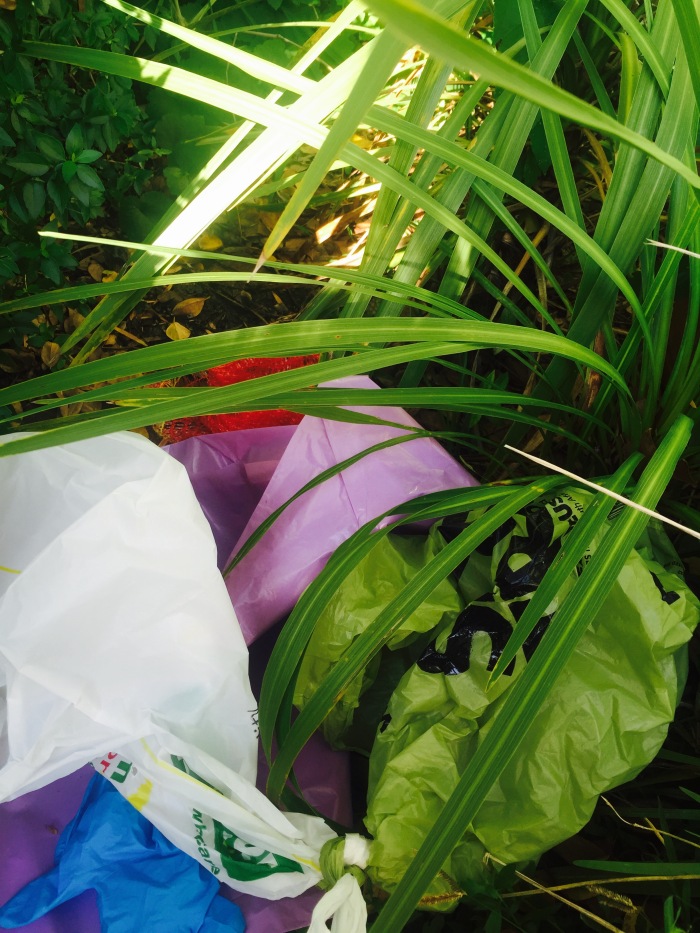This blog post aims to tell the stories of human experiences of trees, by means of different people’s narratives. This will be done by use of photo elicitation. Photo elicitation is based on the idea of inserting a photograph into a research interview. According to Tinkler (2013:173), this relieves some pressure from interviewee when they are asked questions because they have a point of reference.The photograph becomes a medium between the interviewer and the interviewee (Tinkler 2013:174). It ensures that the interviewee can supply the interviewer with the exact information that they are looking for. It also serves as a great way to evoke emotions and memories from the interviewee (Tinkler 2013:174).

The picture above is a very old photograph of a tree that I used to have in my garden, in fact, it was my personal favourite tree. Besides hold a pinata’s for birthday parties, the tree was of great service to my family and I. It provided an area of thick shade over the grass, and it was great fun to climb. I remember my brother setting up both a fufi slide as well as a dog wash from its branches.

The tree in the above image, is known by many of my friends and I as ‘The Tree’. It is a tree that can be found on campus behind the Merensky Library. This is a tree of power, because this is the tree where I met a lot of my university friends. In first year, we met a friend who used to sit at this tree- he was a very quirky and interesting guy and always attracted new friends. And so, a system was put into place that was known as ‘The Tree Group’ which involved about 30 people. Different people of different races, cultures and different faculties would meet under the tree should they have a break in between classes. I loved our system, and I will always cherish the memories and friends that I made at The Tree.

I have grown up living in the Brooklyn area, and so I have always had a hue of purple around me. I have not attended a single educational institution that did not have Jacaranda trees on its property, and so I have spent many moments moving around in attempt to have a Jacaranda flower fall on my head just before I wrote a test or exam- which is supposed to be good luck. I have also experienced many early morning wake up’s from photographers on the street outside my bedroom trying to get photos of the purple carpet before it gets disrupted by cars.

In the above photograph there is a group of unruly trees. This photograph was taken while I was on a hike in Cape Town, somewhere near Table mountain, with my aunt. I noticed that many of the trees in the area were being chopped down, as can be seen by the logs of wood in the photo. But I noticed that these trees were in an inconvenient position to be cut down as they were too elevated and too close to the edge of a cliff, and too tall to be cut down easily. It made me feel very happy to see the trees that refused to move.
Interview 1: My Mother
My mother grew up on a farm in Rhodesia through most of her youth. She was surrounded by trees, and spent much of her time outside with them. Her favourite tree of service is somewhat of an unconditional narrative. My mother used to take piano lessons- which she disliked very much, and so, one morning she decided that she did not want to go to her lessons that afternoon. She found a mango tree, clung to the branch and swung back and forth for as long as she thought necessary. She then went off to her lesson, and immediately showed her teacher her hands that were full of blisters from swinging on the mango tree- the tree did her a great service and she was allowed to be excused from her lesson.
A tree of power that my mother grew up with was another tree on the farm. My mother’s father was an artist, and so he used to paint the things around him a lot of the time. There was a group of trees that my mother was always particularly fond of because they used to create somewhat of a forest effect near their house. On the morning of my grandfather’s passing, he began to paint a picture that included this group of trees. Unfortunately he did not finish painting the picture, because he passed away that afternoon of a heart attack, but my mother cherishes the unfinished painting very much. We now have it hanging up in our house, and my mother will often look at it and remember her father and all of the adventures that she had amongst the trees.
My mother’s tree of heritage of choice is also the Jacaranda trees which loves so very much. She was very happy to move to an area of purple when the opportunity arrived. Not only does she love the colour that surrounds our house and fills parts of our garden, but she also loves the popping noises that the flowers make as she drives down our street.
My mother’s narrative of an unruly tree is perhaps the most unruly of them all. At her previous house the was a very large Mulberry tree that her whole family disliked because of the purple stains all over the floor; not to mention the colours that the birds were constantly leaving behind after eating the fruit. They wanted more than anything to get rid of it, but the problem was that the Mulberry tree was in a very inconvenient place because it was surrounded by their house and walls. There was no possible way of removing it. And so they attempted to cut off some of the branches, which didn’t work very well. The fruit season after they attempted to cut off the branches ended up being the worse yet because there seemed to be double the stains and double the birds than any of the previous years. And so the Mulberry tree stayed, and my mother’s family moved.
Interview 2: My Father
My dad’s dad was a horticulturalist, and so my dad always felt as if he knew too much about the plants and trees around him. Because of this, my dad’s garden’s were always very strategically planned out. And so, my dad’s choice of tree of service is one which was over a large patch of grass in his garden. He remembers always having shade to play in when he was little.
Having an horticulturalist as a father, my dad was always aware of the strategic planning of the trees around him. This shows my dad’s knowledge of the human control over nature. My dad’s narrative of a tree of power includes many trees all over Pretoria. My grandfather often planned the planting and removal of trees near highways (to ensure the safety of drivers). And so, my dad will always point out areas that my grandfather worked on.
My dad’s narrative of heritage and the unruly tree are both about the same tree- the Jacarandas. Like me, my father grew up surrounded by Jacarandas and their purpleness. The difference is that he has a very strong dislike for them. At first, he was rather fond of them- or perhaps it was my mother who convinced him to become fond of them when we moved into the Brooklyn area after he had spent 10 years away from them. But now, 20 years later he can not stand them. He dreads November because he knows that when the purple flowers start to show, rain will follow it. And when the rain arrives, the beautiful purple flowers will turn into brown, bad smelling mush that sticks to the tyres of his car, and makes his pool cleaning much more difficult than it needs to be.
Interview 3: My friend, Kaylyn
Kaylyn’s grew up in Hazelwood with a park full of trees just across the road from her. Her favourite of these trees is the biggest of all of them and it has a swing hanging from it. This is her community’s tree of service. Often, children go across to swing from the swing that hags from the tree. Even at the age of 20, Kaylyn still visits the swing to get in a few moments of serenity into her busy days. The trees around her also assist in this service because of the relaxing mood that they set.
When I mentioned ‘The Tree’ to Kaylyn through the photo elicitation, she immediately grew more excited about the interview. She too, has so many fond memories of the tree where we made so many new friends. Kalyn still thinks it’s funny and so unlikely that a tree would hold so much power and be so unifying to a group of people.
Kalyn’s first thought of a tree of heritage is a tree that stands tall at her primary school. The tree is said to be one of the oldest trees in South Africa (if Kaylyn remembers correctly). Not only does this tree bring about a rich history that Kaylyn loves to mention every time we drive past it, she knows that her primary school is very proud to contain the tree on their property.
Kaylyn’s narrative of an unruly tree is one in her own garden. Her house and the house next door used to be one big house together. It has since been divided into two with the placement of a fence right down the middle of the garden. Unfortunately, there was a tree in the way of the division. The builders were planning on cutting out the tree in order to complete the fence, but the roots were too deep and the trunk was too thick. And so, the fence was built in such a way that the tree is apart of it. The unruly tree refused to move, and preferred to become a part of the fence than to cease to exist.
This blog post has included a photo elicitation which has evoked many emotions and memories from the people that I interviewed. I found that the interviewees were more enthusiastic about their narratives having being guided by my own photographs and narratives. This clearly shows the benefits of photo elicitation.
Sources consulted
Dean, J. 2015. The unruly tree: stories from the archives, in Urban forests, trees,and greenspace: a political ecology perspective, edited by LA Sandberg, A Bardekjian & S Butt. New York: Routledge:162-175.
Tinkler, P. 2013. Using photographs in social and historical research. London: SAGE.




















